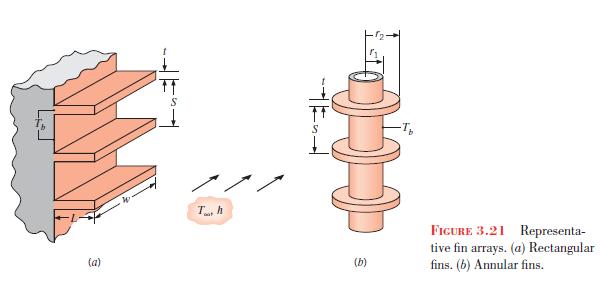Due to blockage of fluid flow, the convection heat transfer coefficient for the finned and prime surfaces
Question:
Due to blockage of fluid flow, the convection heat transfer coefficient for the finned and prime surfaces of a fin array in general decreases as the number of fins increases. Consider the fin array shown in Figure \(3.21 a\), with wall height of \(20 \mathrm{~mm}, w=20 \mathrm{~mm}, t=\) \(2 \mathrm{~mm}\), and \(L=20 \mathrm{~mm}\). The fins are aluminum and the base and environment temperatures are \(T_{b}=95^{\circ} \mathrm{C}\) and \(T_{\infty}=20^{\circ} \mathrm{C}\). As a first approximation, assume \(h=h_{\max } \times\) \(\left(1-N / N_{\max }\right)\) where \(N_{\max }\) is the maximum number of fins that can be placed on a surface, so that \(N_{\max }=\) \(20 \mathrm{~mm} / 2 \mathrm{~mm}=10\). For \(h_{\max }=50 \mathrm{~W} / \mathrm{m}^{2} \cdot \mathrm{K}\), determine the total heat rate for \(N=0,3,6\), and 9 fins.
Figure 3.21:-

Step by Step Answer:

Fundamentals Of Heat And Mass Transfer
ISBN: 9781119220442
8th Edition
Authors: Theodore L. Bergman, Adrienne S. Lavine





